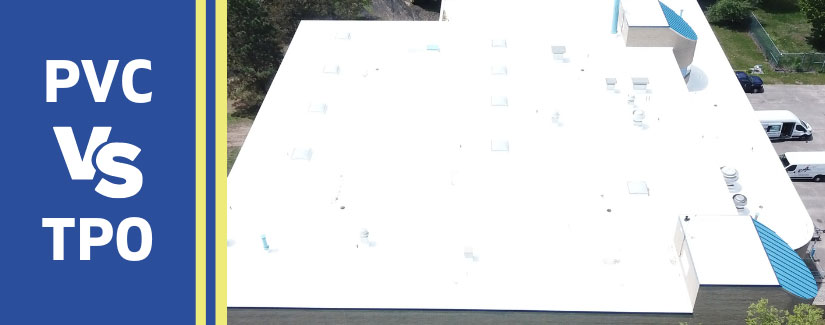Which type of flat white roofing is best?
As a building owner, understanding your roofing system will help you to make better decisions when it’s time for repairs and for scheduling regular maintenance. You may have purchased your commercial building after the roof was installed, so how much do you know about the type of flat white roof you have? Some basic background information about the different types of flat white roofing systems on the market will give you the knowledge to keep your roof in good condition. If your roof’s life cycle has come to an end, you’ll be better informed in choosing a new flat white roof for your building.
There are two main types of commercial flat white roofing systems on the market today, PCV and TPO. They may look very similar to the untrained eye, but there are many differences in terms of energy efficiency, formulation of materials, the way they are installed, and their costs over the entire life cycle of the roof.
What are they made of?
PVC roofing systems have been on the market since the 1960s. Polyvinyl Chloride (PVC) roofs have a membrane consisting of vinyl, UV light inhibitors, resin, heat- stabilizers, plasticizers, and biocides. The PVC membrane consists of 3 layers that are laminated together into a “single-ply”. The top layer is the performance layer. The middle layer is the weft-inserted anti-wicking scrim. The density of this middle layer is key to the strength and durability of the membrane. Duro-Last has among the highest in the PVC roofing industry with 18×14 threads per inch. For Duro-Last, a reflective white base layer is used, and all three layers are laminated together. The importance of a white base layer in terms of the Solar Reflective Index (SRI) is discussed further below. Due to the proprietary makeup of the PVC system, these roofs are strong, flexible, inherently fire retardant, and resistant to most chemicals.
TPO roofing systems were first introduced to the roofing industry in the 1980s as a lower-cost alternative to PVC. Thermoplastic Polyolefin (TPO) is made of polypropylene, ethylene-propylene rubber, and various fillers such as carbon, fiberglass, or talc mixed with polymers. A TPO roof membrane consists of 3 layers that are bound together… 2 layers of TPO that sandwich a polyester-reinforced fabric center, aka “scrim”. TPO is strong, flexible, has low flammability, and is resistant to some chemicals. However, it is less resistant to punctures and weathering than PVC. TPO is also less resistant to chemicals than PVC, so it’s not a good choice where harsh chemicals or grease are involved (restaurants, manufacturing facilities, etc.). Some TPO manufacturers use inferior formulations when fabricating their membranes, which can lead to cracking. These are all important things to keep in mind when weighing the pros and cons of PVC versus TPO roofing.
Energy Efficiency
In the past 20 years, with rising energy costs, roofing manufacturers and commercial building owners have started to increase their focus on keeping energy costs down. Having an energy-efficient roof means more than just lower energy bills…it also means a more comfortable and productive environment and lower long-term maintenance costs.
During the summer months when air-conditioning costs skyrocket, it’s important to know the Solar Reflective Index (SRI) of your roofing system. The SRI value tells you how well your roof reflects light energy, and how well it releases absorbed heat. The SRI measurement is taken when the roof is new and again when it is 3 years old. The higher the number, the better the roof is at keeping your building cool.
A white PVC roof has an initial SRI value of 108, and it decreases to 90 after 3 years. A white TPO roof has an initial SRI value of 98 and decreases to 83 after three years. Although there is not a large difference in these values, PVC is the clear winner in terms of energy efficiency.
Sustainability
The best measure of a sustainable roof is one that lasts a long time! PVC roofs have a long service life that cannot be matched by any other type of roof. Some PVC roofs have been in service for 30 years or more, which reduces the environmental impacts of manufacturing and shipping. PVC roofing is the ONLY type that is recuperated in entirety at the end of decades of service life and then recycled into new roofs.
TPO roofs can last 15-20 years, however, in regions with extreme UV exposure it has been proven that their life cycle can be shortened by several years. Once a TPO roof has reached the end of its life, it can be melted down, re-extruded, and used for the bottom ply of new membranes…however, most TPO manufacturers are not currently doing this. Between 5-15% of TPO is recycled into new roofs.
In 2009, NSF/ANSI 347 was created as a standard for measuring and evaluating the sustainability of single-ply roof systems over their entire life cycle. Each single-ply roofing system is assessed in each of the following 5 areas: product design, product manufacturing, membrane durability, corporate governance, and innovation.
Duro-Last, the leading manufacturer of PVC roofing materials, has been certified sustainable for 5 of their most popular membrane options for NSF/ANSI 347, including one gold and two silver certifications. TPO membranes, on the other hand, have not earned the same certifications from NSF/ANSI 347.
Cost
As a commercial building owner aiming to make the best choice when selecting a new flat white roofing system, it’s a good idea to think about “value engineering”. In a nutshell, value engineering means prioritizing durability and functionality so that you end up with a roof with a long lifespan. A long-lasting roof allows you to amortize its cost over a longer period, which is a better value for you.
Any time you substitute cheaper materials, you are supposed to end up with the same performance at a lower cost. If you take the example of TPO roofing which was introduced in the 1980s as a cheaper alternative to PVC roofing, you are substituting a lower-cost material, but you are also getting a lower performance. Although TPO may cost less at the outset, you will accrue higher costs over the life cycle of the roof due to maintenance and replacement costs.
Another important cost difference to consider between TPO and PVC roofs involves the installation methods. TPO and PVC roofs can be installed using “roll goods” that are laid out on the roof and then the seams are heat-welded on site. The difference with PVC roofing is that there is an option for “custom prefabrication”.
Custom prefabrication means that the exact measurements for your roof are taken on-site, and then the entire roof is manufactured in a factory-controlled environment. If you take the example of a Duro-Last custom prefabricated PVC roof, 80% of the seams are welded in the factory. For a 42,000 square foot roof, a typical roll goods TPO system will require 5,130 feet of seams to be made by hand, on-site. With a Duro-Last prefabricated system, only 1,278 feet of seams need to be completed in the field.
In terms of quality, durability, and cost, the factory-welded seams of a prefabricated PVC roof are superior to TPO seams that are prepared during roof installation. With TPO, time must be taken by installers while they are on the roof, to cut the membrane to size and to make the boots and stacks for the penetrations. Human error while cutting and heat-welding can create gaps and defective seams. These may not be apparent at the outset, but with time they are weak points in your roof that can result in future leaks and the costs associated with repairing them.
The custom prefabricated roof arrives ready to go, so the installation time is minimal, and you have less interruption for your business. While the initial membrane costs of PVC are higher than that of TPO, the cost is in the membrane material, which stays with your roof. In terms of value engineering, it makes more sense as a building owner to prioritize spending on high-performance materials than spending on labor, which leaves at the end of the job.
Warranties
Most commercial building owners are busy and would rather put off reading their roof warranty to a later date…usually when roof leaks occur, and they realize they need repairs. Don’t make this mistake! There are major differences in the warranties that different flat roofing system manufacturers are offering, and these could make or break your business if you have problems with your roof later on down the road. Carefully consider the warranty that is being offered with your roofing system, before deciding what type of flat roof is best for your business.
The best and most comprehensive roof warranty that we know of on the market is from Duro-Last for their custom-prefabricated PVC roof system. They offer a 15-year “No Dollar Limit” warranty with every commercial roof installation. It covers consequential damages, such as loss of business, that could occur if your roof were to leak due to faulty materials or workmanship. Duro-Last has taken extensive measures in-house to produce the very best roofing materials, then every single commercial roof is inspected by a Quality Assurance technician to ensure that the roof has been installed to Duro-Last’s high standards. You can rest assured that for 15 years you will not have any out-of-pocket costs for roof leaks due to inferior materials or installation methods.
Call Great Lakes Roofing & Insulation
Choosing a roofing system and a roofing contractor are both very big decisions to make. Great Lakes Roofing and Insulation has been serving northern Michigan for more than 35 years. Allow us to answer your questions and assist you throughout this process. Reach out to us today at 989-575-0190.

